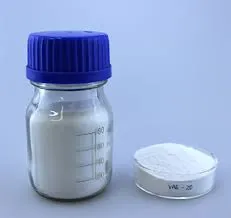
Sep . 28, 2024 16:32 Back to list
rdp powder
Understanding RDP Powder Properties and Applications
RDP powder, or Redispersible Polymer Powder, is an essential additive used widely in construction, adhesives, and manufacturing. As the demand for high-performance materials increases, RDP powder has gained popularity due to its unique properties and versatility.
What is RDP Powder?
RDP powder is a free-flowing, white powder made from various polymers through a spray-drying process. It is primarily characterized by its ability to be redispersed in water, forming a stable dispersion. This unique property makes RDP an excellent choice for numerous applications, particularly in cement-based formulations.
Key Properties of RDP Powder
One of the most significant advantages of RDP powder is its excellent film-forming ability. When mixed with water, it creates a cohesive film that enhances the overall performance of construction materials. This film provides improved adhesion, flexibility, and water resistance, making it indispensable in various applications.
Additionally, RDP powder improves the workability of mortars and adhesives. It allows for easier manipulation and application, thus enhancing the efficiency of construction projects. As a result, workers can achieve better results with less effort, reducing labor costs and time.
Another noteworthy property of RDP powder is its compatibility with various substrates. It can bond well with multiple surfaces, such as concrete, wood, metal, and plastics. This versatility enables the formulation of products tailored to specific applications and requirements.
rdp powder

Applications of RDP Powder
The applications of RDP powder are vast and diverse. One of its most common uses is in tile adhesives and grouts. The improved adhesion and flexibility offered by RDP ensure that tiles remain securely in place, even under challenging conditions.
RDP powder is also extensively used in rendering and plastering applications. The powder enhances the performance of the mix, resulting in a smoother finish and better crack resistance. This is particularly valuable in exterior applications, where the material is subjected to various environmental stresses.
In addition, RDP powder is integral to the production of self-leveling compounds. Its ability to enhance the flow and leveling properties of the mixture ensures a uniform surface, which is crucial for floor applications. This quality is especially important in commercial spaces where aesthetic appearance and functionality are paramount.
Furthermore, RDP powder is found in the production of paints and coatings. By incorporating RDP into these formulations, manufacturers can create products with enhanced adhesion, durability, and water resistance. This results in longer-lasting finished surfaces that can withstand the test of time.
Conclusion
In summary, RDP powder is a versatile and high-performance additive optimal for construction materials, adhesives, and coatings. Its unique properties, such as excellent film formation, workability enhancement, compatibility with various substrates, and diverse applications, make it a valuable resource in the building industry. As construction technologies continue to evolve, the importance of RDP powder will only increase, solidifying its role as a key component in modern materials.
-
Versatile Hpmc Uses in Different Industries
NewsJun.19,2025
-
Redispersible Powder's Role in Enhancing Durability of Construction Products
NewsJun.19,2025
-
Hydroxyethyl Cellulose Applications Driving Green Industrial Processes
NewsJun.19,2025
-
Exploring Different Redispersible Polymer Powder
NewsJun.19,2025
-
Choosing the Right Mortar Bonding Agent
NewsJun.19,2025
-
Applications and Significance of China Hpmc in Modern Industries
NewsJun.19,2025







